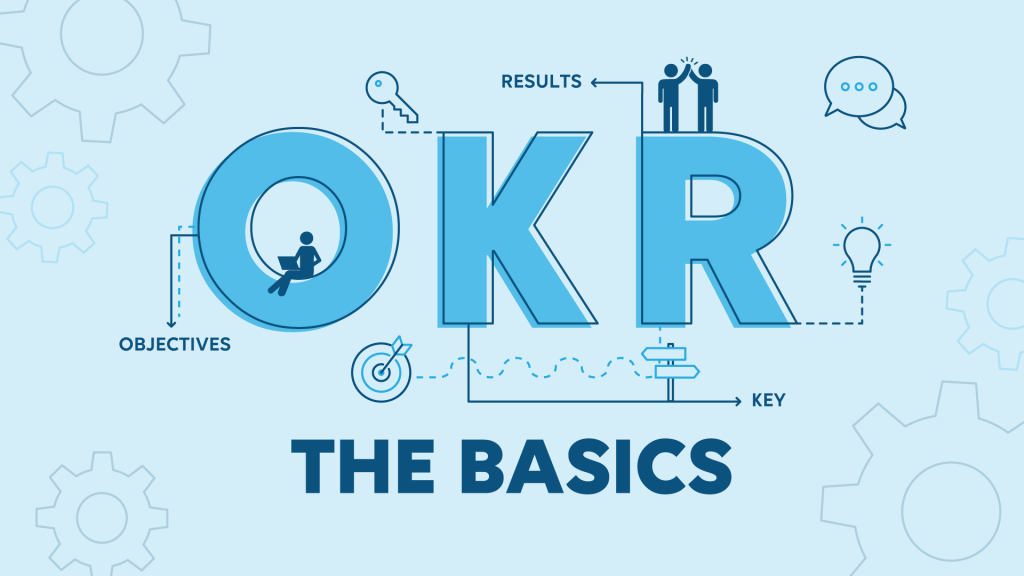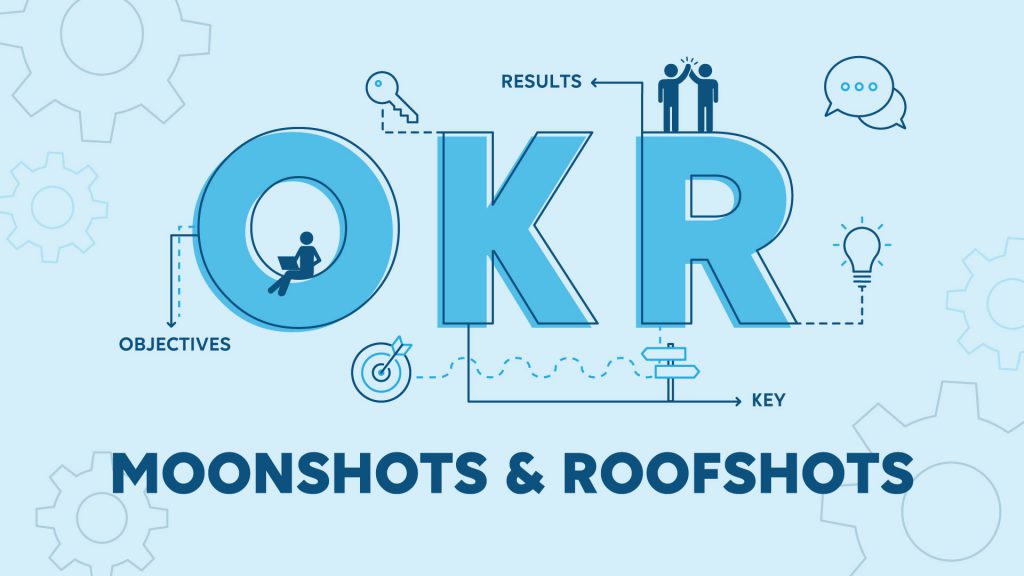The OKR goal-setting framework provides a unique advantage by motivating individuals and organizations to venture outside their comfort zones through a practice known as ‘stretching’. By setting ambitious objectives and key results, organizations can push themselves beyond their limits.
However, it’s important to strike the right balance between setting achievable targets and reaching for the stars. While overstretching can lead to disappointment and repeated failure, understretching can lead to a false sense of achievement. In this blog post, we’ll explore the different types of OKRs and how to choose the most suitable ones for your specific goals—with examples taken from our very own Skyline OKRs.
What are OKRs? How do they work? And why should you use them? Learn all about the basics of OKRs in our blog post “OKRs: an introduction to the basic concepts”.
Swiftly navigate this blog post
The 3 main types of OKRs
Depending on just how far an OKR is stretched, they can be classified into 3 types of OKRs
– Committed OKRs: Although they represent a challenge, individuals/teams should achieve the results at 100%
– Aspirational OKRs: A real challenge that pushes individuals/teams to achieve ambitious things in the next cycle.
– Learning OKRs: A learning opportunity that we want to pursue next cycle
For an in-depth comparison between committed OKRs (roofshots) and aspirational OKRs (moonshots), read “moonshots and roofshots”.
Committed OKRs
Committed OKRs or roofshots are goals that, despite being challenging (an inherent characteristic of any successful OKR), are expected to be achieved 100%. Therefore, teams/individuals will have to adjust their resources and schedules to ensure the objectives are fulfilled completely.
Committed OKRs are typically aimed at improving day-to-day operations and are therefore often called “operational goals“.
In short
✔️ What? Goals that are hard, but achievable
✔️ Context: Operational goals or goals that are aimed at improving day-to-day operations
✔️ Success criteria: 100%
example
O: Increase our team’s visibility and engagement with our community
KR: Create 3 blog articles to be published during this quarter.
KR: Create a training course on CI/CD by the end of the quarter.
KR: Ensure that questions on our Q&A forum related to our team are answered EOD during this quarter.
Aspirational OKRs
Aspirational OKRs, moonshots, or “stretch goals” represent ambitious objectives with the purpose of pushing everyone’s limits and setting a new definition for what is perceived as possible. These are the OKRs that may feel uncomfortable but ensure that the team steps out of their comfort zone.
Aspirational OKRs typically represent a new project that has never been done before by the team: a disruptive product to be created, a process that will be completely renewed, or something with high risk but which also brings great value. Indeed, the main purpose of these aspirational OKRs is to push boundaries, encourage you to rethink your work, and stimulate creativity and new ideas. When you grade an aspirational OKR, the expected score will be around 60-70%, with a lot of room for variance.
In short
✔️ What? Often called stretch goals, beyond the threshold of what seems possible
✔️ Context: Goals that stimulate creativity and new ideas
✔️ Success criteria: 60-70%
example
O: Expand our billing models in order to offer more options to our clients
KR: Kick off a new consumption-based model by the end of the quarter.
KR: Launch a communication campaign highlighting the benefits of this new consumption-based model by the end of the quarter.
RK: Create a calculator in our portal that allows our customers to decide the best model to use.
Learning OKRs
Roofshots and moonshots are the most discussed and well-known OKRs of the bunch. But they’re not the whole story!
Committed and aspirational OKRs are great for achieving outcome-based objectives, driving progress and achievement toward a clear goal. But when the focus is on gaining knowledge and insights, we use “learning OKRs”
Learning OKRs encourage teams to test and learn when the outcome is perceived as uncertain and focus on gaining knowledge and experimenting with new ways of achieving a result. Typical use cases for “learning OKRs” include using a new programming language to determine if it is more efficient, listening to feedback from customers on a newly implemented feature, or adopting a new work methodology by the team.
Keep in mind, however, that while learning OKRs are a valuable tool for experimentation and gaining insights, there is a risk of getting bogged down in analysis and not taking enough action to drive results. So, implement them wisely.
In short
✔️ What? Learning OKRs encourage teams to test and learn when the outcome is perceived as uncertain
✔️ Context: Goals that focus on gaining knowledge and insights
example
O: Increase the quality of our deliverables
KR: Implement 5 Ranorex tests for our solution by the end of the quarter.
KR: Implement 5 Selenium tests for our solution by the end of the quarter.
KR: Implement 5 Cypress tests for our solution by the end of the quarter.
As you can see, different needs imply different strategies.
What do we perceive as success? How high can/should we aim? What’s our current context? Are we in the middle of a crisis/reorganization or do we have room to innovate and embrace new challenges? All these questions are essential to answer when choosing the right OKR for your teams.
Now, while committed, aspirational, and learning OKRs mainly focus on stretching the “objective” of the OKR, we can also apply a similar strategy of stretching to our key results.
Stretching key results
Key results are the measurable outcomes required to achieve your objective. They define how you will reach your goals and ensure you can track, measure, and discuss your progress.
Depending on their stretch levels, key results can be defined as either a hold, an increment, or a leap. Your choice will depend on how far are you trying to move forward over the course of the OKR cycle.
Hold
The “hold” key result is used to indicate that we want to maintain the same level of effort. At first glance, this key result might seem a bit unintuitive because it goes against the premise of “effectuating change”. However, sometimes it is necessary from a strategic point of view to ensure that good work continues to be done.
Let’s imagine the following situation: the support team is currently undergoing an organizational restructuring phase, with different members being reallocated between teams. Since the level of customer support provided should be the same regardless of the restructuring, maintaining the steadiness of the operation is key to the team’s success.
example
KR: Maintain our current MTTR (Mean Time to Repair) metric from 4 hours for 90% of our customers by the end of the quarter.
Increment
In an “increment” key result, we want to indicate an intention to reach a certain level of progress compared to the current situation. Perhaps it is necessary to increase the number of interactions by the Sales team with some focus accounts, maybe it is necessary to hire more developers to reinforce a Cloud team, or perhaps it is necessary to capture more value from an existing procedure.
example
KR: Increase the cloud connection adoption from our customers from 60% to 70% by the end of the quarter.
Leap
Finally, the “leap” key result indicates a clear and notable effort towards innovation and disruption, whether through the creation of a new product or process, the capture of new markets, or the search for non-traditional competitive advantages for the organization, among other examples.
example
KR: Create the feature “Storage as a Service” by the end of quarter 3.
Let’s wrap it up
In the end, it all boils down to the attitude required to address the challenges and the context behind them.
How far do you need to stretch your efforts to achieve success? Is this the appropriate stretch level for the company at this exact moment? And what tone do you want to convey to direct your team’s actions? …
These are all fundamental questions that should support the choice of the most appropriate OKR. The OKR framework is, above all, a communication tool that describes what success looks like. For that, the correct intentionality for action is essential so that OKRs are properly perceived and executed.
Discover the complete blog series on OKRs

BLOG | OKRs
PART 1 – Introduction to the basic concepts
Let’s deep dive into the basics of OKRs: what they are and how you can implement them

BLOG | OKRs
PART 2 – The benefits of OKRs: F.A.C.T.S.
What can OKRs bring to a company, a team, and you as an individual? Let’s talk F.A.C.T.S.

BLOG | OKRs
PART 3 – OKR cycle – plan, evaluate, adapt, repeat
Learn how to correctly implement the 4 phases of the OKR cycle

BLOG | OKRs
PART 4 – Moonshots and roofshots
Moonshots or roofshots? aspirational or committed OKRs? What are they and how should you use them?